
(1) Important cultural property
Black-lacquered peach-shaped helmet with side decorations
in the shape of large water buffalo horns
16th Century
Owned by Fukuoka City Museum
Photo by Fujimoto Kempachi
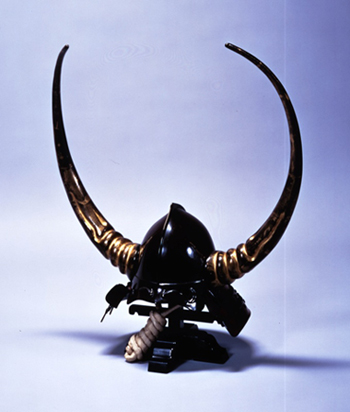
(2) Important cultural property
Acorn-shaped helmet with black bear fur
16th Century
Owned by Sendai City Museum
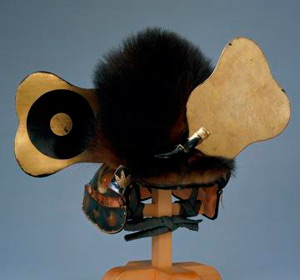
This helmet is a part of the “silver iyozane cuirass armor with white lacing” possessed by the Date family. The helmet is considered to have been gifted to Date Masamune (1567-1636) by Toyotomi Hideyoshi (1537-1598) in 1590, because it matches the description of the record of the Date family that “a helmet with bear fur” with “fans on both sides” was given by Hideyoshi.
With black bear fur, showy fans gilded on both sides, and lacquer work with a chrysanthemum and paulownia design at the center, this gorgeous helmet perfectly matches the style of Hideyoshi.
(3)Helmet in the shape of a bear head
18th Century
Private collection
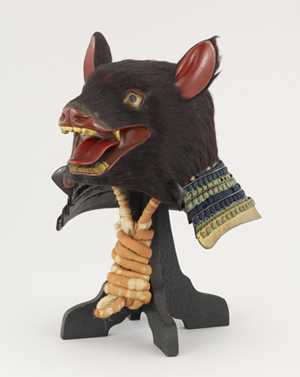
During the Edo period, kawari kabuto helmets came in a greater variety of forms. In this peaceful period, helmets were no longer necessary for their original purpose, and became lavishly decorated ornaments. Throughout the Edo period, various uniquely designed helmets were produced, including unusual and over-decorated ones, and these have been handed down through generations to the present time.
With a bear head on its iron bowl, lacquered red and painted gold, this is one of the most unique helmets produced in the Edo period.
(4) Important cultural property
Short-sword mounting covered with a gold plate-embossed from the back,
with a design featuring a kikko turtle shell pattern
16th Century
Private collection

Used by Hosokawa Yusai (1534-1610) and Hosokawa Sansai (1563-1645), this gorgeous sword mounting has been handed down in the Hosokawa family. It was made by covering a plain wood scabbard with a thin gold plate embossed from the back, with the family crests of the Hosokawa family―nine stars and diamond-shaped flowers―neatly arranged on the scabbard. The precise and complete depiction of the background patterns indicates that this was made by the best craftsman of those days. This mounting, including the metal fittings, could have been entirely gold, but the craftsman opted partly to use black in the sword-hilt washer and pommel and rivet, which made this product vividly impressive. The craftsman must have had a great artistic sense.
(5)Tangible cultural property
designated by Iwate Prefecture Long-sword mountings,
each with a pheasant head-shaped ornament at the hilt
17th Century
Morioka History and Culture Museum
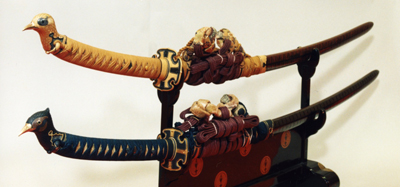
These are precise replicas of the sword mountings gifted by the Ashikaga Shogun family to the Nanbu family. The originals were lost in a fire. These mountings were the most important treasures of the Nanbu family, and always shown at the top of the list of heirloom items of the family. They are characterized by the heads of male and female pheasants made by combining metal parts of various colors attached at the ends of the hilts and fine notches engraved on the bodies of the hilts that represent feathers. The end of each scabbard is shaped like a wing, on which a feather pattern is depicted by colored lacquer. These mountings are the products of sophisticated metal carving and lacquering techniques, and wondrously, appear to be a pair of real pheasants when looked at from a distance.
(6) Sword mounting with a vermillion scabbard with a fine notch pattern
19th Century
Sano Art Museum
(Photo shows part of the item)
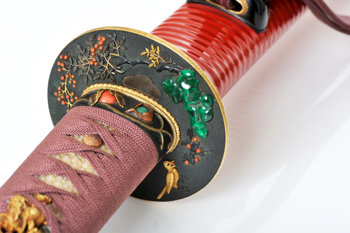
This lavish mounting consists of a beautiful scabbard on which a fine notch pattern is lacquered in vivid vermillion with metal fittings inlaid with various materials. The sword guard is provided with the name of the craftsman, Kaizan Oki, a goldsmith in Kyoto active in the late Edo period, and an inscription that reads “Created in 1808 on receipt of an order.” On the sword guard, a small bird picking fruits of heavenly bamboo and coral bush is colorfully depicted by coral and cloisonne inlays and high relief carving with color inlay. Probably, the craftsman, upon request, made this sword guard to match the sword-hilt washer and pommel that was similarly designed but made by another craftsman. This colorful product must have had a great appeal for wealthy townspeople of those days.

Owned by Kuroda Nagamasa (1568-1623), the first lord of the Fukuoka Domain, this helmet is characterized by side decorations in the shape of large water buffalo horns. For this characteristic, this helmet has been long known as “Nagamasa’s large water buffalo helmet.” Despite its weighty appearance, it weighs only 2,650 grams and is highly practical. The bowl of the helmet naturally matches with the huge horns on both sides, which creates a pleasant sense of balance, while giving a sobering quality. Indeed, this is one of the greatest masterpieces of Japanese art, fraught with the intense atmosphere of the warring period.